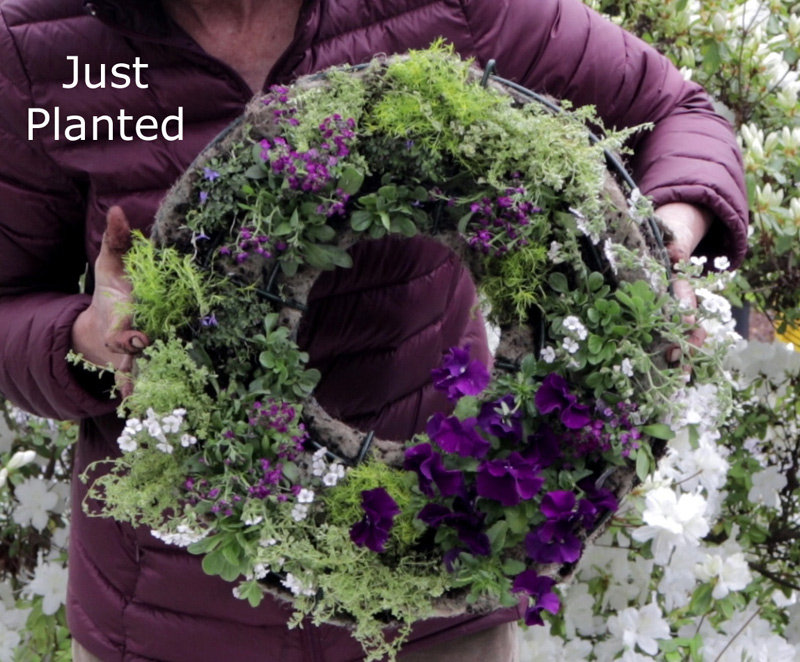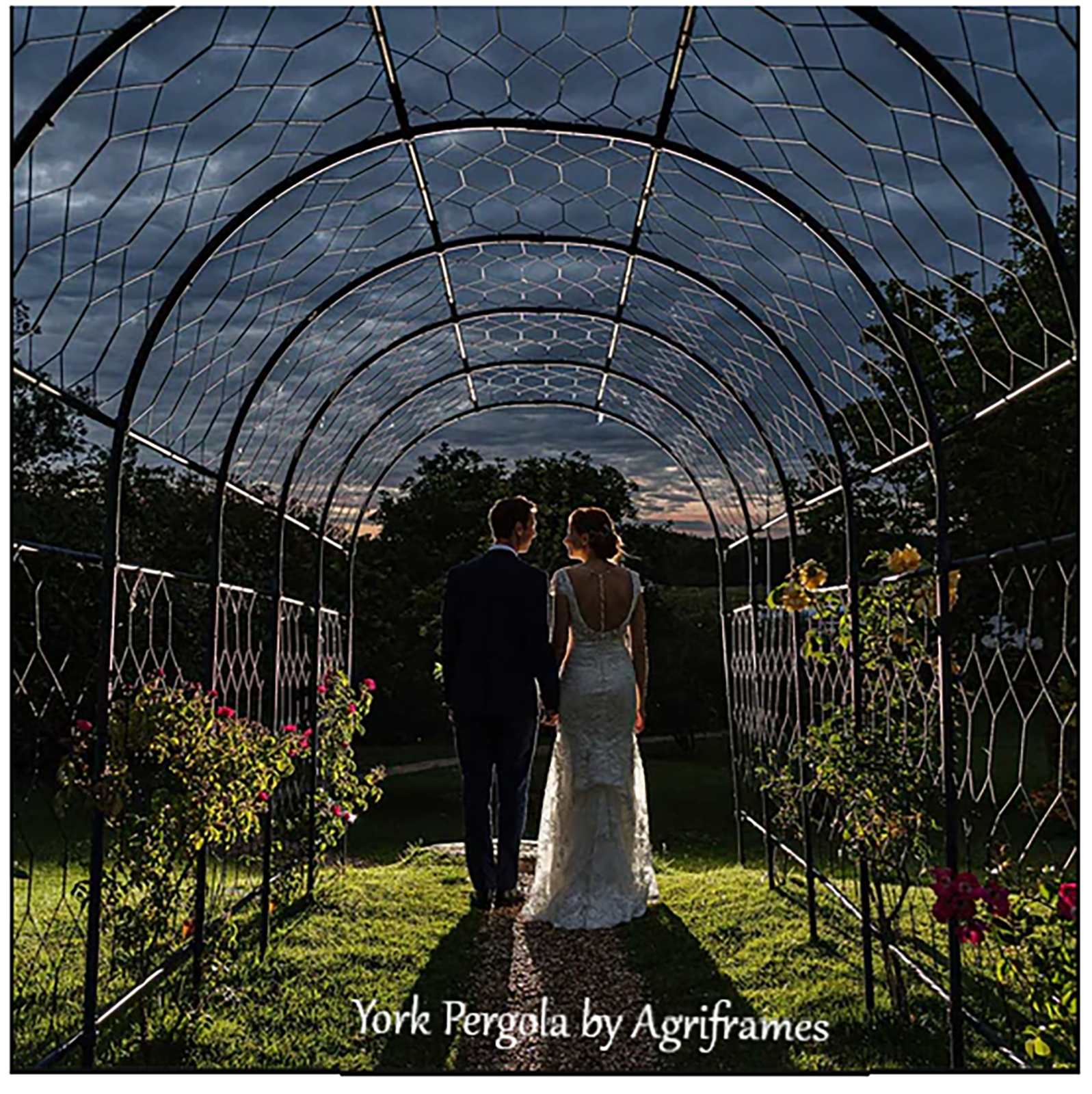
Posted on May 01, 2017 | by Kerry K
Living wreaths are a unique and lovely accent for your home. When greeted by such a stunning creation on the front door, the vistor immediately knows a clever and dedicated gardener lives within! But it doesn't stop there--they can also be used to decorate a wall or fence, or laid flat to surround an umbrella pole, vase, candles, or planter. Depending on the plants you choose, they can be suitable for sun, shade, or in-between.
Did you know that one woman from California is credited with their invention? Mary T. Colbert was a garden writer for the L.A. Times, as well as contributing many articles to garden-themed magazines over the years. In 1976 her creation of a wire and sphagnum moss wreath complete with live plants garnered attention nationwide. She followed up 20 years later with a book, "The Living Wreath," and made the rounds of TV garden shows, demonstrating her craft.
Using a metal frame with a jute liner, and small, low-growing plants, you can create a beautiful wreath that with care can last an entire season, or even years in some cases. Look for low-growing, spreading plants, especially those often used for groundcovers. You'll find many sold under brand names such as Jeepers Creepers, Steppables, or Treadwells, but they'll be less expensive if you find the same plant without the associated marketing costs! There are lots to choose from, most of them bloom at some point during the season, and some may be evergreen depending on your location.
The wreath we made below used perennial Scotch moss, creeping Baby's Breath (Gypsophiloa repens), Pratia 'County Park,' and 'Harrington Silver' Thyme; annual purple sweet alyssum, and one purple viola. It will need some time to fill in but is already a beautiful "mini garden".
Plugs or cell-pack plants are ideal, but most larger pots of creeping plants can simply be sliced or cut like a cake--just be sure the plants have an adequate root system. We cut each perennial plant into 4 pieces. Our wreath used a total of 25 individual plant pieces, since we wanted to get to a finished look quickly. You could easily use half that many and let them grow--a couple of weeks should allow them to fill in fairly well. Plants were placed randomly, but well-mixed. The viola was used as a "bow."
How to Plant a Living Wreath
Step by Step:
- Remove top ring and liner, fill bottom generously with potting mix, add slow-release fertilizer, and firm in well.
- Plan your design to ensure even coverage--cut any plants you need to. Mark the liner where you want to place your plants. Keep the ring on the liner to guide you while you mark so you don't end up having a ring on top of one of your plants. You can also mark the radial lines of the ring on the liner to make easier placement later.
- Cut where you marked-- Xs, not holes. The cut "X" shape will create flaps that will allow the plant to be placed, but will also keep the soil in. Making actual round holes may allow soil to fall out, especially if you cut too large.
- Place the cut liner over the wreath, covering the soil.
- Now you have a choice--you may attach the metal ring over the top liner NOW, and plant within the spaces. OR, you may plant WITHOUT the ring, then later place the ring over the liner AND plants once they are in place. It is easier to plant without the ring in place, but harder to place the ring after planting if your plants are very full. We chose to place the ring first and push the plants within the spaces.
- Open the "flaps" you cut and insert plants into the potting soil. You can make root balls narrower by soaking them first, then squeezing and forming them like modeling clay. If you lose some of the roots, don't worry--plants are usually pretty resilient.
- Continue to place your plants until all the spots you cut are filled. If you planted with the ring off, now you will need to place over the liner and plants and secure.
- Check sides and firm up any spots where soil may be leaking--squeeze into shape.
- Water well and place out of direct sun for the first few days. Check for water needs every day until you learn how much water your wreath will need. Wreath should be kept moist, and not allowed to dry out--it is recommended to lay the wreath flat for even watering. How much water will depend on the type of plants you have chosen, as well as sun and wind conditions.
- As plants grow, you may need to prune a bit to retain your wreath's shape. Just trim where you need to--plants won't mind! Blooming plants may benefit from deadheading or light shearing. Generally floral shears, or even kitchen scissors do just fine.

If you like, you can add some preserved sphaghum or spanish moss under the rings here and there to cover up the liner--it adds interesting texture, as well.
Wreaths with perennial plants can be placed on ground and covered with evergreen boughs or dry leaves for winter to protect roots from freezing. With any luck, many of them will return for another season!
Other Planting Ideas:
- Hot, sunny spot: succulents such as creeping sedums, hens & chicks, ice plant, and portulaca will grow well
- Shady place: Super Elfin impatiens will brighten up dimly lit areas--larger cultivars will end up looking leggy. Or, try a combo of different colors and varieties of selaginella (club and spike) mosses.
- Try ajuga, ivies, dwarf iberis, or dwarf mondo grass for evergreen accents. There are so many new varieties of ajuga one could use only those to create a multi-colored wreath, with yellow, orange, pink, cream, purple, green and white! For the most part, foliage plants with small leaves will look most appropriate.
- For a springier look, use Scotch or Irish moss, low-growing thymes, and violas. Leaf lettuces are a fun addition that can be harvested, as they tend to be cut and come again.
- Good flowering annuals include alyssum, bacopa, lobelia, and compact bidens varieties
- Spreading herbs such as golden oregano, greek oregano, corsican mint and thymes will add fragrance and foliage interest
- Other good perennial candidates include creeping veronicas such as 'Georgia Blue,' pratia, leptinella, dwarf armeria, isotoma, low-growing campanulas (C. poscharskyana), antennaria (pussytoes), cerastium, and laurentia
- Those in deep southern regions can opt for creeping ficus or baby's tears (soleirolia)--others can grow them as annuals.
- Small growing bromeliads like cryptanthus can also be used--you can add some preserved sphagnum moss in between to cover the liner.
- Sphagnum moss liners can be used instead of jute if you prefer that look.
Remember: Plant recommendations may not be suitable for all areas. Please check with your state Natural Resources department, county extension agency or master gardener's program to determine whether plants may be invasive in your location. Happy Gardening!
















